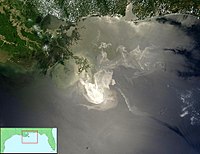
Photo from wikipedia
Abstract Oil spills have adverse effects on the environment and economy. Near real time detection and response activities enable to better manage the required resources at the incident area for… Click to show full abstract
Abstract Oil spills have adverse effects on the environment and economy. Near real time detection and response activities enable to better manage the required resources at the incident area for clean-up and control operations. Multi-temporal remote sensing (RS) technologies are widely used to detect and monitor oil spills on the Ocean surfaces. However, current techniques using RS data for oil spill detection are time consuming and expensive in terms of computational cost and related infrastructure. The main focus of this work is oil spill detection from voluminous multi-temporal LANDSAT-7 imagery using high performance computing technologies such as graphics processing units (GPUs) and Message Passing Interface (MPI) to speed up the detection process and provide rapid response. Kepler compute architecture based GPU (Tesla K40) with Compute Unified Device Architecture (CUDA), which is a parallel programming mechanism for GPU is used in the development of the detection algorithms. Oil spill detection techniques that were adapted to GPU based processing include band-ratio and Morphological attribute profile (MAP) based on six structural and shape description attributes namely, Gray mean, standard deviation, elongation, shape complexity, solidity and orientation. Experimental results show the significant gains in the computational speed of these techniques when implemented on a GPU and MPI. A GPU vs. CPU comparison shows that the proposed approach achieves a speedup of around 10 × for MAP and 14 × for band ratio approaches, which includes the data transfer cost. However, the MPI implementation using 64 cores outperforms the GPU, and executes the time intensive task of computing the above said attributes in only 18 min, whereas a GPU consumes around an hour.
Journal Title: Remote Sensing of Environment
Year Published: 2017
Link to full text (if available)
Share on Social Media: Sign Up to like & get
recommendations!